
Lead generation for e-commerce is significant in the process of attracting prospective customers inside and transforming them into leads who are interested in a product or service. Quality leads are an elixir for an e-commerce business, as it would be the platform where the business continues to grow and generate more sales. Rather than targeting a mass audience, lead generation pinpoints people who are truly interested in the products, hence showing higher conversion rates.
E-commerce processes usually include content marketing, paid advertisement, and a series of campaign activities by the social media platform to reach the potential customer’s attention. Success lies in targeting the right audience, value provision, and engaging leads through personalized contact. Quality lead generation is what helps an e-commerce business build a robust customer base, up retention, and eventually bring in more sales and revenue.
Quality leads convert themselves into paying customers, thus establishing a connection between the generation of leads and the eventual emergence of higher conversions.
Understanding Lead Generation for E-commerce
E-commerce lead generation refers to a methodology wherein potential clients with an actual interest in purchasing products or services are identified and targeted. Their contact information is captured, and this can allow lead nurturing with the hope that they will eventually make a purchase.
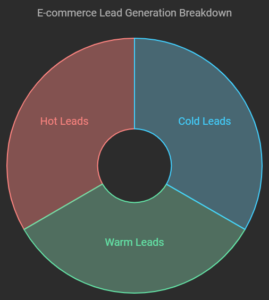
They can be categorized into three types which are: Leads who do not know much about the business, those who are cold leads; those who know and are interested but not ready to buy, these are warm leads; and those who are ready to purchase, which are hot leads. E-commerce firms can engage with leads to nurture them through the sales funnel using targeted content, personalized offers, and retargeting ads.
Cold leads need to build awareness through content marketing and advertising. For warm leads, there is deep engagement, through email nurturing and recommendations on a product, for instance. Hot leads require conversion tactics, such as discounts, free trials, or urgency-driven promotions that may close the deal.
Effective Lead Generation Strategies for E-commerce
1. Content Marketing
Create quality, SEO-friendly content in blog posts, guides, and video content to pull in target audiences and involve them with your business.
Offer free resources such as eBooks or checklists to generate leads from contact details by building an email list for further nurturing.
2. Social Media Marketing
Sources are Instagram, Facebook, and Pinterest-generated lead platforms. Run targeted ads and connect with followers and influencers to increase the visibility of the brand to scoop up potential leads and push traffic through e-commerce sites.
3. Email Marketing
An email list needs to be designed through opt-in forms, newsletters, and lead magnets. Automated email campaigns could nurture leads by offering tailor-made content, product recommendations, and offers that will nudge them along the pathway to purchase and convert them into customers.
4. Paid Advertising (PPC)
Fourth, paid ads on Google and Facebook bring qualified potential leads. With the help of retargeting strategies, visitors who had visited but did not convert return; so that conversion of these people into paying customers becomes possible.
5. Search Engine Optimization (SEO)
The high visibility, organic traffic into multitudes, and maximum use of all product pages, blog content, and website structure on search engines ensure that leads are captured from active search engine users who actually are looking for the product or service.
Utilizing Lead Magnets for E-commerce
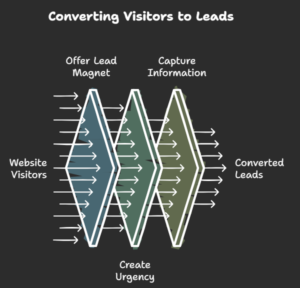
A lead magnet is an offer, be it in the form of a discount or exclusive offers to free trials that is used as a lure and captures potential customer information in return for value. Lead magnets play a major role in converting people who visit e-commerce websites into leads. Offer something very relevant and of immense value to your target audience to make your lead magnets absolutely irresistible. For instance, offering a discount that’s timely, a preview of new products, or a free trial could inspire guests to leave their contact information. Basically, the offer must meet the customer’s interests and create a feeling of urgency or exclusivity.
Building and Optimizing Landing Pages
It encompasses creating and fine-tuning a landing page where conversion can occur. Meaning, a lead-capture page has to be quite clear and focused on sending an intended message that persuades visitors toward action. You can start building a good landing page by initiating it with an attractive headline that straightforwardly conveys value in the offer. After the headline, a call-to-action, or a CTA, comes next. This should be in bold, concise, and action-oriented words such as “Get Started” or “Claim Your Discount.”
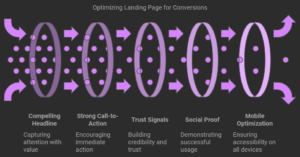
Customer reviews and other trust signals, such as a security badge, a badge of privacy assurances, or industry certifications, create credibility and trust associated with your business. Social proof is the assurance that other people have successfully utilized your product or service. So it needs to be very clear, totally free from distractions, and solely made for conversions. Optimize the landing page for mobile and ensure it works on every device. Well-tuned landing page ensures high conversion rates and smooth generation of leads in business-to-business e-commerce commerce.
Leveraging Customer Reviews and Testimonials
One of the better tactics that can be used while building up trust and creating fresh leads is through the use of customer reviews or testimonials. When people know other people had a fantastic experience with your products or services, then that product or service is going to become some form of social proof for them. Being that valid customer feedback is displayed on your website, product pages, or landing page, it always helps build credibility and, subsequently, increases the chances of conversion.
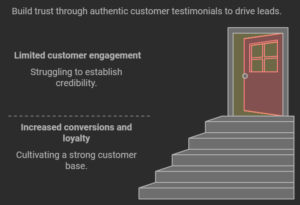
Reward happy customers with discounts on their future purchases or inclusion in promotions for giveaways. Make it easy for them to give you a review by using an easy-to-fill form or by giving links to independent review sites. Finally, follow-up can also help augment your collection of reviews, emails, or social media engagements. Here, now, you have authentic positive real-life testimonials marketing materials with the attraction of leads maximized, conversion rates improved, and a loyal customer base growing for your e-commerce business.
Tracking and Analyzing Lead Generation Performance
It is important to track performance in lead generation so you understand your strategy’s effectiveness and can optimize the efforts put in. Two of the best tools that give you substantial insights into your lead generation activities are Google Analytics and CRM systems. Google Analytics monitors your website traffic and user behavior with an automatically displayed conversion rate. You can then get detailed reports on where your leads are coming from, which pages are doing well, and how visitors have interacted with your site. CRMs, like Salesforce or HubSpot, take control of leads and track them through the sales funnel, providing direct insight into lead quality and customer interaction as well as sales performance.
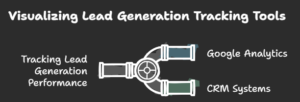
The important metrics to keep track of are conversion rates, lead quality, and cost per lead. Conversion rate is how many visitors take the desired action, such as filling out a contact form or making a purchase. A high conversion rate is a good indication that your landing pages, CTAs, and offers are effective.
Lead quality therefore refers to the chances that a lead may really convert to become a paying customer. It is, therefore essential to measure leads’ engagement as well as behavior when deciding on which are more promising. For instance, downloading a high-value resource or interacting with personalized offers makes a lead a rather high-quality lead.
The CPL measures every dollar spent on acquiring each lead in the production of CPL. Monitoring and ensuring that CPL will be affordable means benchmarking whether the lead generation strategies are cost-effective and where the allocation of the budget would yield the best returns in investment.
By constantly tracking and adjusting some of these metrics, e-commerce businesses can help optimize lead generation activities to result in better conversion rates with maximization of ROI.
Conclusion
In simple words, lead generation strategies take their final shape while helping perfect the development and success of online businesses. One must work in exploiting the opportunities of content marketing, social media marketing, email campaigns, paid advertisement, and SEO to target the most productive leads and take them through the sales funnel. Lead magnets and optimized landing pages can help improve the rate of lead conversion further. Customer reviews and testimonials also work as lead conversion goldmine.
With the tracking of the leading metrics of conversion rates, lead quality, and cost per lead, businesses can continuously ensure a maximum return on investment by adjusting their strategy. The application of these strategies will help e-commerce businesses harvest valuable leads, improve sales, and result in sustained brand loyalty. A good lead generation plan is sure to lead to sustained business growth and improved customer retention.
Integrating these strategies into one’s marketing will allow one to stay ahead of the competition, forever adapting to the changing needs of customers and generating traffic for their websites. In that regard, this all-rounded lead generation will help maintain constant growth and facilitate the strengthening of brand presence within a crowded market.
